The 1840 Babbage Steam Computer or Differential Machine
Somewhere in the 1800s, Charles Babbage invented the first computer, then the word “computer” had a different meaning, and he called his invention the Difference Machine or the Analytical Machine. The ingenious inventor was ahead of his time, but, unfortunately, did not complete his invention, and only a hundred years later the first real computer was invented, but this is another story. And today's article is about the Babbage Analytical Machine.
According to Babbage’s drawings, the machine was to consist of the following parts:
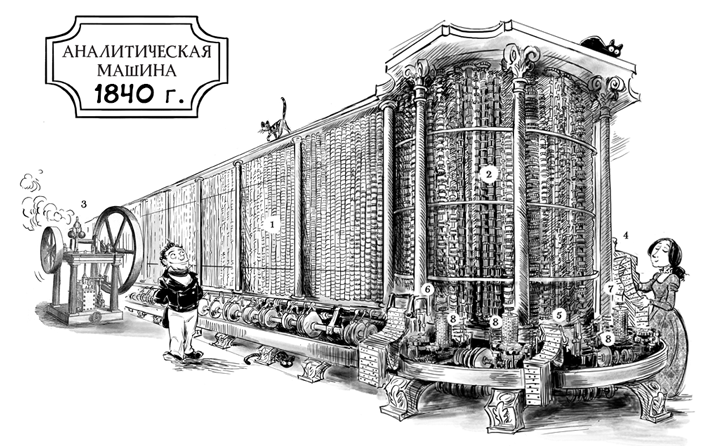
1. Warehouse — hard disk, memory; 2. Mill - processor; 3. Steam engine - power supply; 4. Printer - printer; 5. Cards of operations - programs; 6. Variable maps - addressing system; 7. Numeric cards - for entering numbers; 8. Control drums - firmware.
In this article we will try to find out the device of the Analytical Machine, but first we should note that it belonged to the family of “automatic” (self-) mechanisms that was widespread since the 1740s.
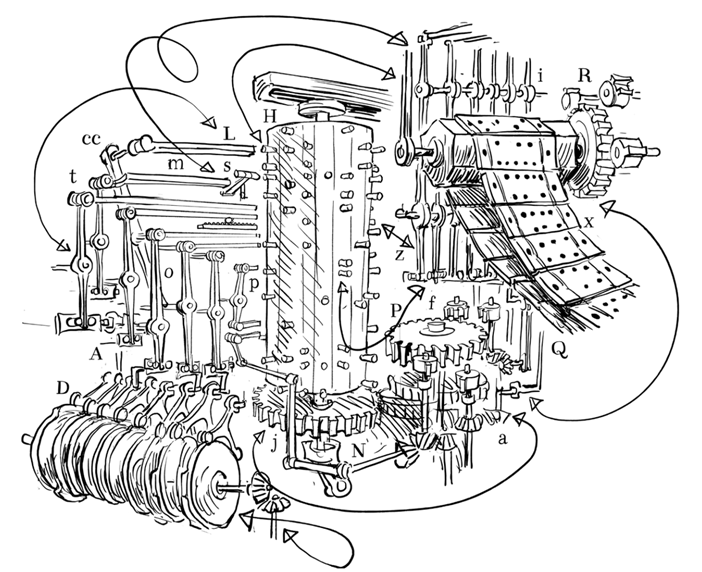
And although Babbage avoided using this concept, in the news and publications it was described in this way:
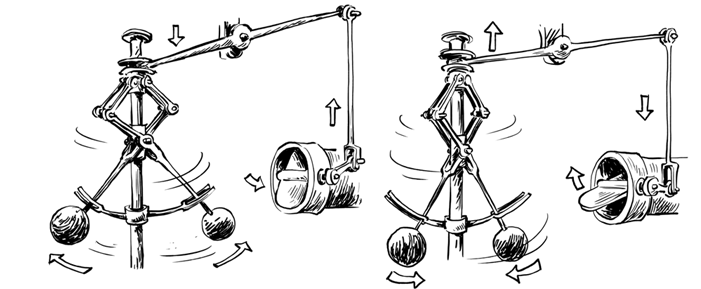
When the engine accelerates, the balls deviate from the axis under the influence of centrifugal force, because of this, the clutch moves and limits the flow of steam, and the car slows down. Slowing the machine lowers the balls and this opens the valve - the steam flow opens, the cycle is closed.
The design of the Difference Machine itself was similar to adding machines, and, like adding machines, the Machine consisted of a long train of gears that add up the numbers, and then give out the sum.
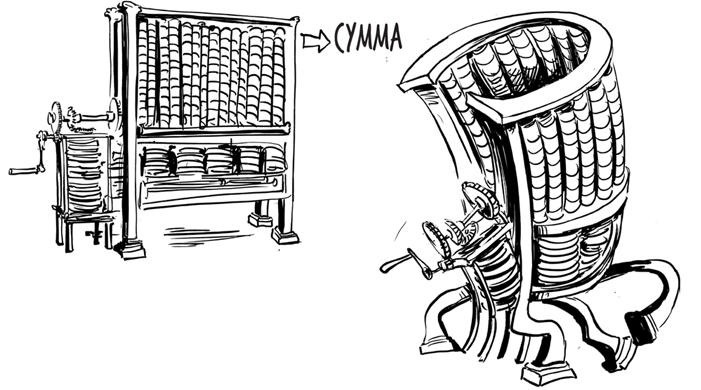
Somewhere in 1834, Babbage improved the design, and by returning the amount back to the machine, more complex calculations became available.
The work of the Analytical Machine was based on “devouring its tail,” and the system worked thanks to a complex chain of gears that were controlled by punched cards and drums, calculating sums and sending the results to a warehouse that consisted of a number of gears.
About all interacted so:
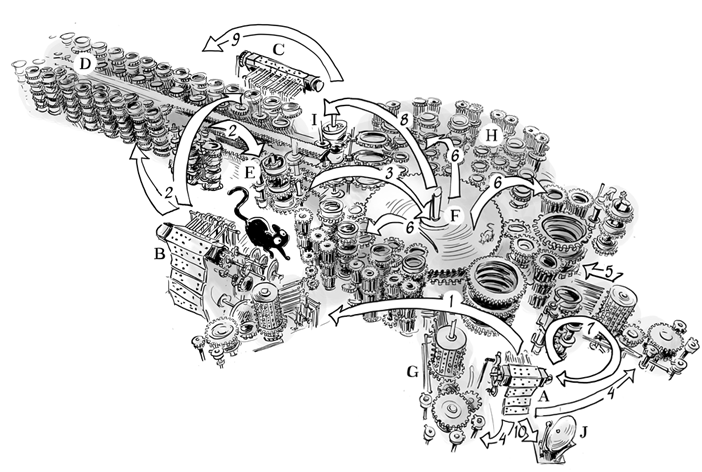

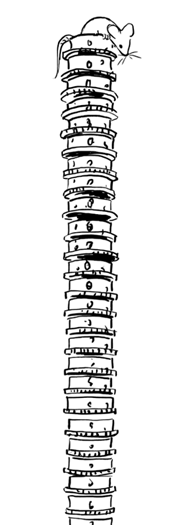
Any computer, steam or electronic, requires the ability to store data. In Babbage's invention, he was called a warehouse, and, like almost the entire machine, it consisted of gear wheels arranged in tall columns. On each of the columns only one number was stored that was no longer than fifty digits, and the upper wheel determined the number positively or negatively.
In addition to cogwheels, numbers could be stored on numerical maps as combinations of holes: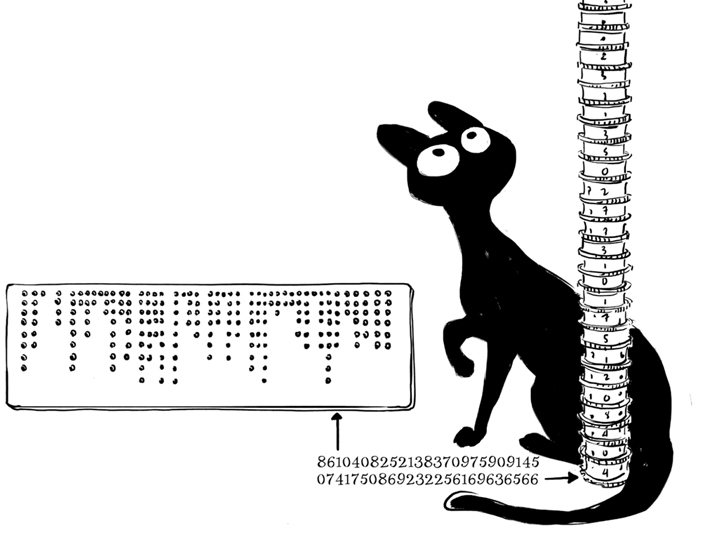
 In his diagrams, Charles depicted a number of columns extending beyond the edge of the sheet and did not indicate the finite number of numbers that the final version of the Machine could remember.
In his diagrams, Charles depicted a number of columns extending beyond the edge of the sheet and did not indicate the finite number of numbers that the final version of the Machine could remember.
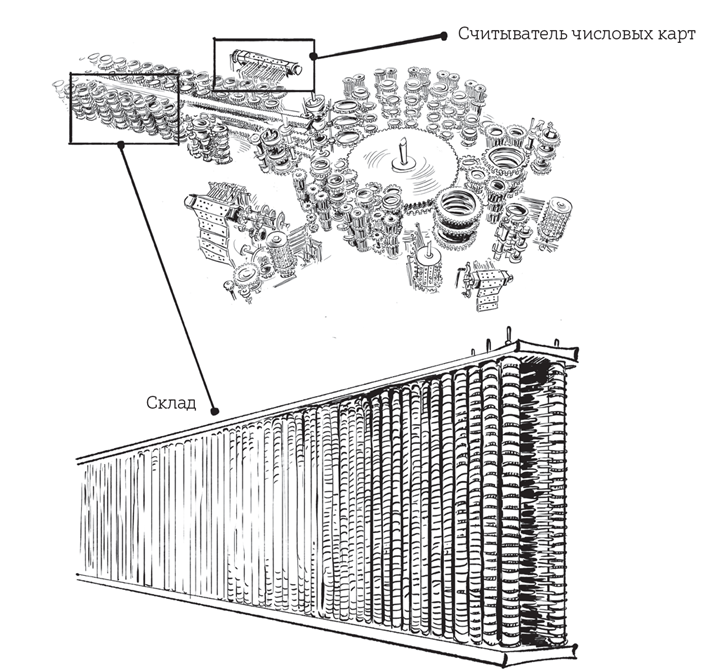
To transfer the numbers from the warehouse to the Machine, Babbage usedgears of the rack with long teeth again . Each of the numerical wheels of the warehouse was connected with rails with the help of gears and with their help the values were transferred to a special column of rings between the mill and the warehouse, and in the same way the numbers were transferred back to the warehouse.
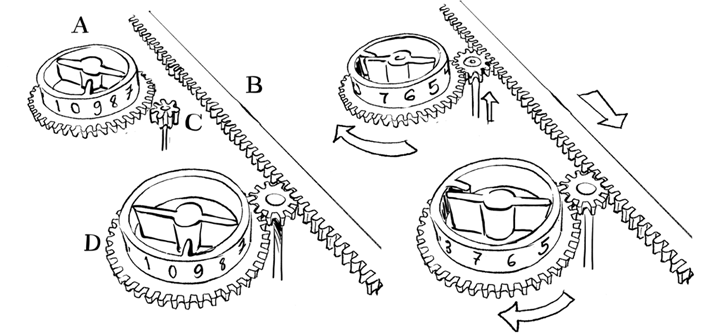
The wheels of warehouse A are connected to rail B by means of a gear. Resetting, the wheel of the warehouse turns the input axis to the position of the transmitted number.
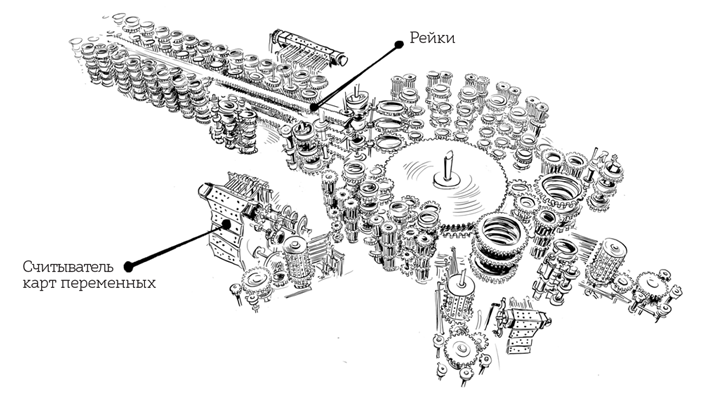
To transmit the number from the far end of the warehouse required a rack length of several meters.
The variable maps have addresses in the warehouse from which numbers are sampled. The same cards can be programmed to receive values from numeric cards.
Each address is plotted on the variable-value cards in the form of holes, and their combination switches certain levers:
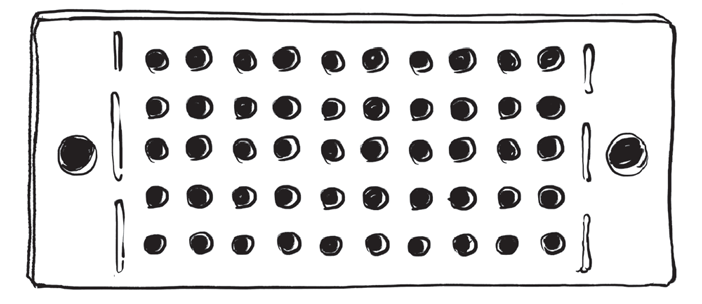

In the absence of a hole on the punched card, the lever is not engaged, but as soon as the hole appeared, the lever connected the gear to the clip. And the gear, rising together with the bracket, connected the input wheel with the toothed rack.
After numbers hit the mill, the main part of the Machine’s work begins - arithmetic operations performed over and over.
Babbage developed separate nodes of addition, subtraction, multiplication and division, as well as one of his favorite mechanisms - the transfer with anticipation.
In his publications, Babbage humanized the Machine and wrote about the “end-to-end transference”:
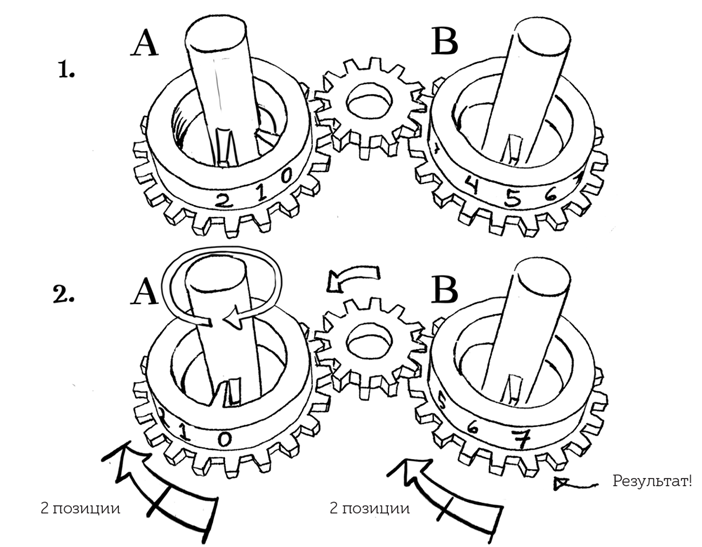
Wheel A is reset and the first number is set on it. The second number is set on wheel B, which, coupled with wheel A. Resetting the first wheel adds the number therein to the value on wheel B.
Take for example:
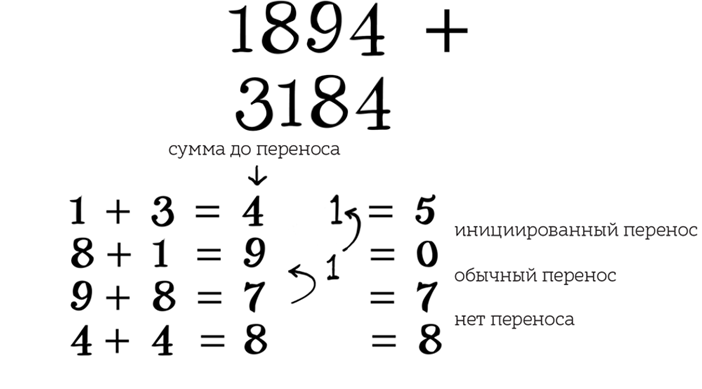
Recall school arithmetic, namely addition to the bar and transfer of units. If you put the numbers of both numbers in columns, as was done in the Machine, and put them in bits, then in the first case there will be no transfer, in the second one will be transferred, and in the third the amount will be equal to 9, but the previously transferred unit will initiate the transfer.
When the Difference Machine is running, one can observe the wave-like movements of the carry levers in the back of the Machine. Waves occur due to sequential hyphenation of units from the bottom up, checking the initiation of new hyphenation.
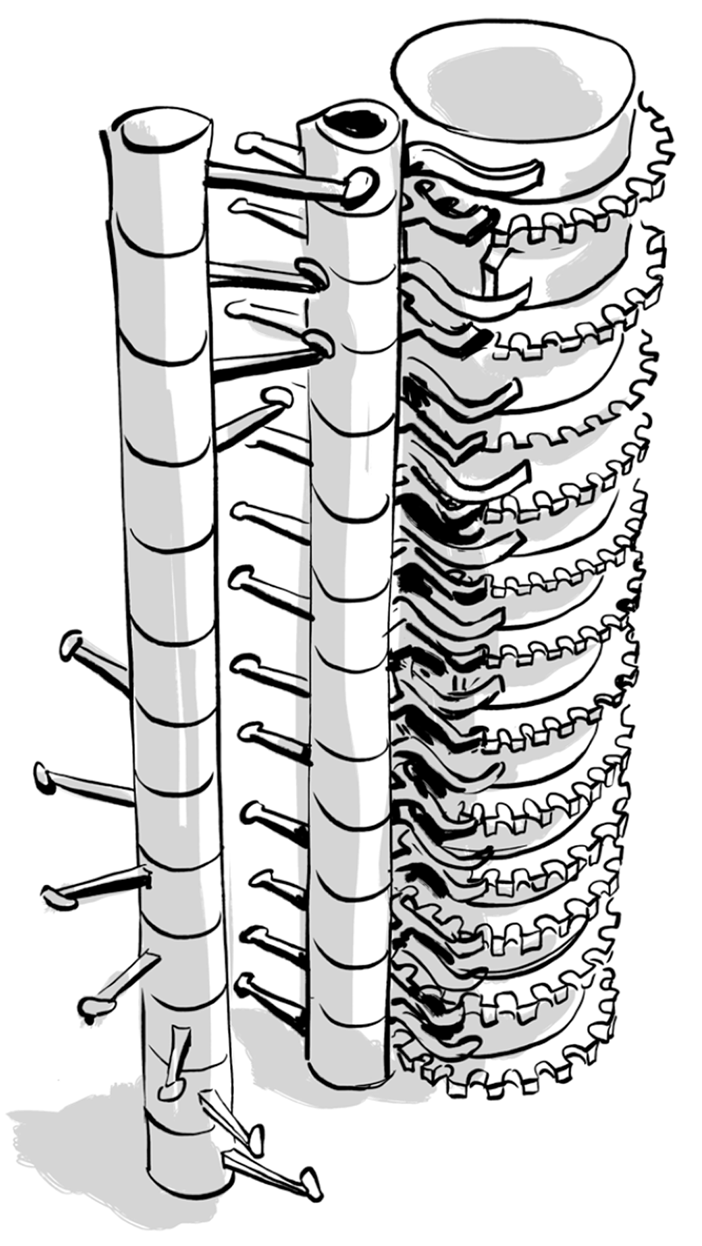
This thing moves the unit up one by one!
There were no programs at that time, or rather, they were already invented, but then they were called operation cards and looked something like this: Ada Lovelace was involved in Program
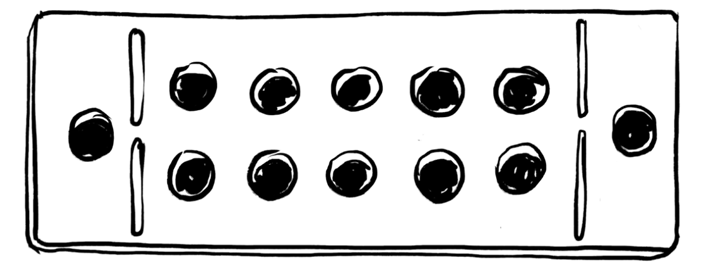
operations
, and, like true aristocrats, they gave orders to drums and variable maps without contacting the working mechanisms . Even simple addition involved many parts, and with the help of a large drum one lever could set any value for eighty other levers.
According to the holes in the cards, the drum turns to the levers in different sections, which contain a specific cipher and use different sets of levers.
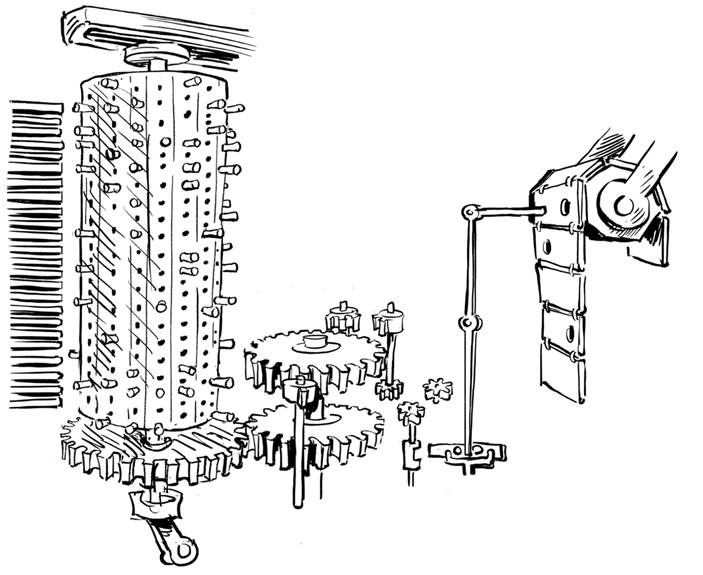
And although the drums remind roller bars, they act differently. Instead of continuous rotation, the drum rotates to a certain position and then moves forward, pushing and activating a set of necessary levers.

The operation cards control both the reels and the variable maps, and look something like this:
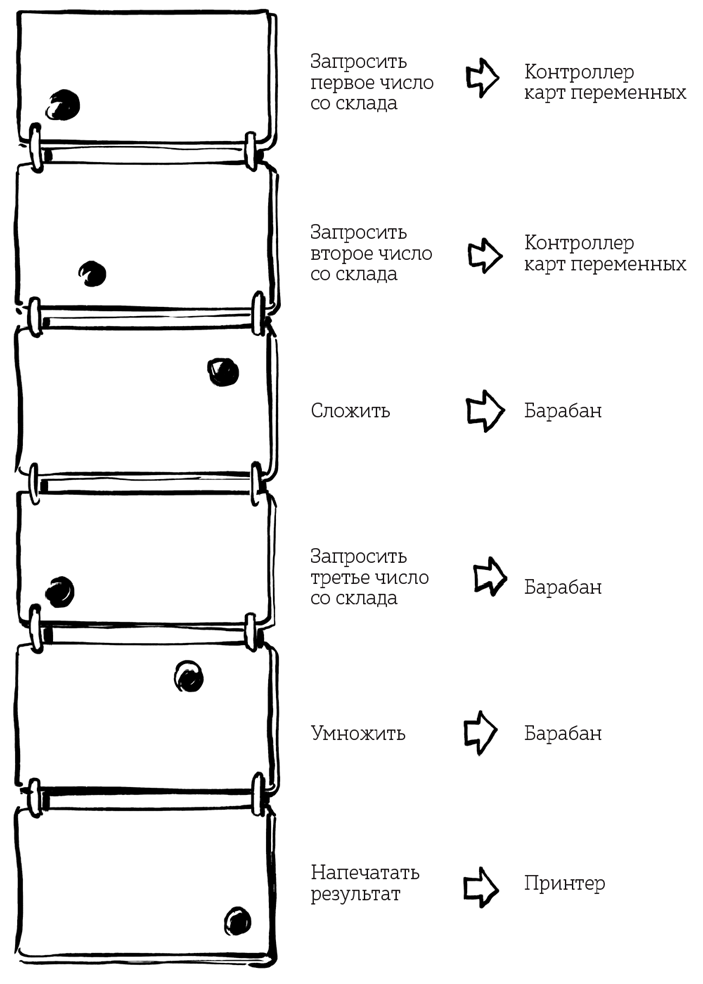
The first system, built on punch cards, was a jacquard loom, and it was he who was inspired by Babbage.
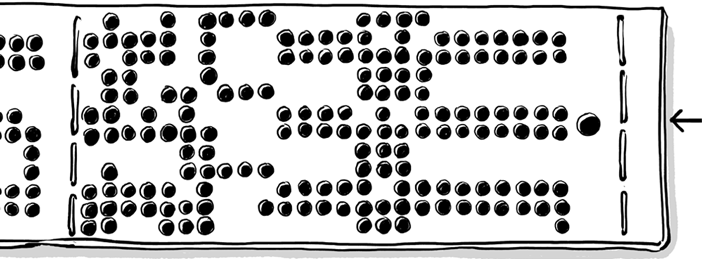
Jacquard's card, 1850. The
principle of their work is simple and ingenious at the same time: the lever holding the punch cards lowers, pressing the card against a set of spring-loaded horizontal pins. If there is no hole under the pin, the card shifts the pin and tilts the rod with the hook so that it clings to the pin. Then the pins move up with the hooks hooked to them.
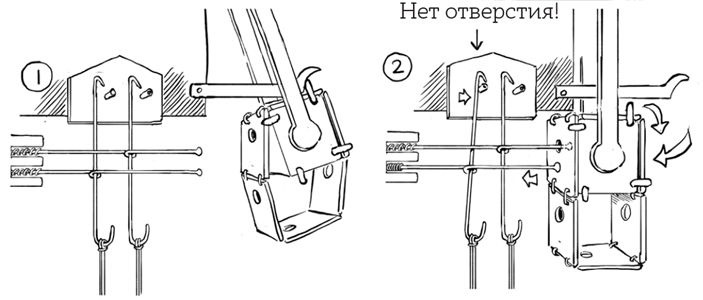
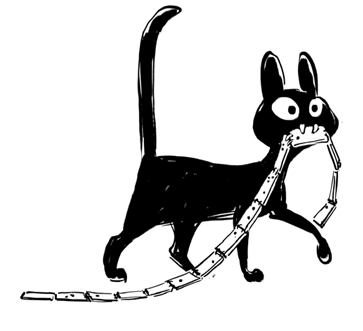
Punch cards and gears are great, but they don’t make the Difference Machine a computer. From the device for calculating the decimal arithmetic Machine turns into a computer thanks to a small part - the conventional lever.

This lever is automatically lowered if the result of the calculations requires further action by the program. And if the pin is at a certain position of the drum, and then the lever is lowered, a new cycle of calculations is launched.
Thus, the conventional lever closes the cycle, and the Machine “eats its own tail”: the punched cards control the drums, the drums by the Machine, the Machine by the drums, and the drums by the punched cards.
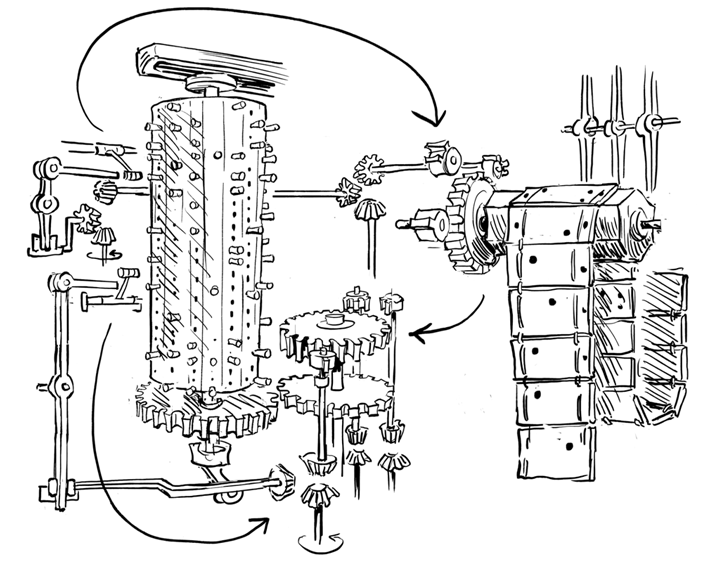
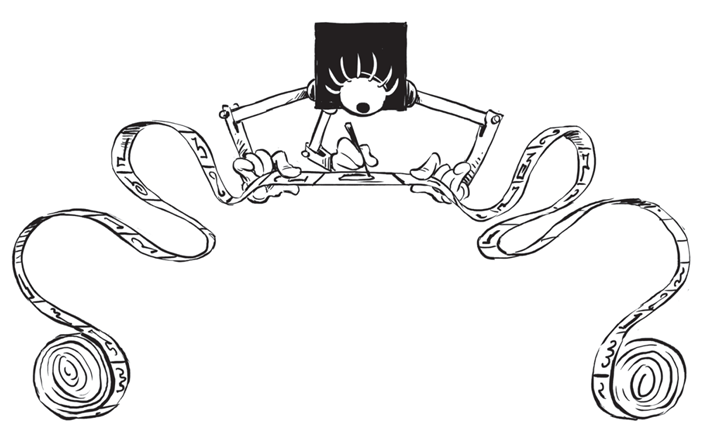
On this I finish today's article. If you have any additions, I will be glad to discuss in the comments.
Have a good day and accurate calculations!

 Literature:
Literature:
“The incredible adventures of Lovelace and Babbage.Almost the true story of the first computer "
Author: Sidney Padua
Publisher: Mann, Ivanov and Ferber, 2017
ISBN: 978-5-00100-943-6
According to Babbage’s drawings, the machine was to consist of the following parts:

1. Warehouse — hard disk, memory; 2. Mill - processor; 3. Steam engine - power supply; 4. Printer - printer; 5. Cards of operations - programs; 6. Variable maps - addressing system; 7. Numeric cards - for entering numbers; 8. Control drums - firmware.
Self-calculating machine
In this article we will try to find out the device of the Analytical Machine, but first we should note that it belonged to the family of “automatic” (self-) mechanisms that was widespread since the 1740s.

And although Babbage avoided using this concept, in the news and publications it was described in this way:
At breakfast, I had the pleasure of sitting next to Mr. Babbage, the famous inventor of the self-calculating machine in our circles. His gaze seems so insightful that he sees science - or any other object that has become the object of his attention - through and through.The centrifugal regulator is the first of the "self-acting" mechanisms of the industrial age. By the way, he is one of the most recognizable parts of the steam engine.
Edie Sedgwick, 1841

When the engine accelerates, the balls deviate from the axis under the influence of centrifugal force, because of this, the clutch moves and limits the flow of steam, and the car slows down. Slowing the machine lowers the balls and this opens the valve - the steam flow opens, the cycle is closed.
The design of the Difference Machine itself was similar to adding machines, and, like adding machines, the Machine consisted of a long train of gears that add up the numbers, and then give out the sum.

Somewhere in 1834, Babbage improved the design, and by returning the amount back to the machine, more complex calculations became available.
The work of the Analytical Machine was based on “devouring its tail,” and the system worked thanks to a complex chain of gears that were controlled by punched cards and drums, calculating sums and sending the results to a warehouse that consisted of a number of gears.
About all interacted so:

- Cards of operations (A) indicate to cards of variables (B) that it is necessary to request numbers for calculations;
- The numbers are entered from the number cards (C) or from the warehouse (D) and in turn are fed to the input axis (E);
- The input axis transmits the numbers to the center wheels (F);
- The operation map gives the command to add numbers or multiply or otherwise, and the reels (G) rotate to the position in which their pins correspond to the operation.
- The drums activate the levers by connecting the gears of the mill (H) to the central wheels. And already in the mill, certain devices are responsible for addition, multiplication, and other actions;
- Gears perform multiplication of the original numbers;
- The mill, if necessary, can loop the action, passing commands to different parts of the punch card;
- The result falls on the output axis (I).
- The output axis transfers data to the printer (D) or sends it to the warehouse according to variable cards;
- Operation cards issue a command to make a call (J) and to stop the Machine. Everything!

Memory: warehouse

Any computer, steam or electronic, requires the ability to store data. In Babbage's invention, he was called a warehouse, and, like almost the entire machine, it consisted of gear wheels arranged in tall columns. On each of the columns only one number was stored that was no longer than fifty digits, and the upper wheel determined the number positively or negatively.
According to my estimates, it will take a long time before these restrictions cease to satisfy the needs of science.In Babbage's drawings, the warehouse consisted of two parallel rows of high numeric columns, and each one contained one number. One side of the warehouse communicated with the mill.
Charles Babbage
In addition to cogwheels, numbers could be stored on numerical maps as combinations of holes:

 In his diagrams, Charles depicted a number of columns extending beyond the edge of the sheet and did not indicate the finite number of numbers that the final version of the Machine could remember.
In his diagrams, Charles depicted a number of columns extending beyond the edge of the sheet and did not indicate the finite number of numbers that the final version of the Machine could remember.
Reiki and variable maps for data transfer
To transfer the numbers from the warehouse to the Machine, Babbage used

The wheels of warehouse A are connected to rail B by means of a gear. Resetting, the wheel of the warehouse turns the input axis to the position of the transmitted number.

To transmit the number from the far end of the warehouse required a rack length of several meters.
The variable maps have addresses in the warehouse from which numbers are sampled. The same cards can be programmed to receive values from numeric cards.
Each address is plotted on the variable-value cards in the form of holes, and their combination switches certain levers:


In the absence of a hole on the punched card, the lever is not engaged, but as soon as the hole appeared, the lever connected the gear to the clip. And the gear, rising together with the bracket, connected the input wheel with the toothed rack.
Windmill computing
After numbers hit the mill, the main part of the Machine’s work begins - arithmetic operations performed over and over.
Babbage developed separate nodes of addition, subtraction, multiplication and division, as well as one of his favorite mechanisms - the transfer with anticipation.
In his publications, Babbage humanized the Machine and wrote about the “end-to-end transference”:
In the case of end-to-end transfer, the Machine is able to anticipate and act in accordance with the foresight.Of course, before the transfer of the number it was necessary to add, and it happened like this:
Charles Babbage

Wheel A is reset and the first number is set on it. The second number is set on wheel B, which, coupled with wheel A. Resetting the first wheel adds the number therein to the value on wheel B.
Take for example:

Recall school arithmetic, namely addition to the bar and transfer of units. If you put the numbers of both numbers in columns, as was done in the Machine, and put them in bits, then in the first case there will be no transfer, in the second one will be transferred, and in the third the amount will be equal to 9, but the previously transferred unit will initiate the transfer.
When the Difference Machine is running, one can observe the wave-like movements of the carry levers in the back of the Machine. Waves occur due to sequential hyphenation of units from the bottom up, checking the initiation of new hyphenation.

This thing moves the unit up one by one!
Programs
There were no programs at that time, or rather, they were already invented, but then they were called operation cards and looked something like this: Ada Lovelace was involved in Program

operations
, and, like true aristocrats, they gave orders to drums and variable maps without contacting the working mechanisms . Even simple addition involved many parts, and with the help of a large drum one lever could set any value for eighty other levers.
According to the holes in the cards, the drum turns to the levers in different sections, which contain a specific cipher and use different sets of levers.

And although the drums remind roller bars, they act differently. Instead of continuous rotation, the drum rotates to a certain position and then moves forward, pushing and activating a set of necessary levers.

The operation cards control both the reels and the variable maps, and look something like this:

Punch cards
The first system, built on punch cards, was a jacquard loom, and it was he who was inspired by Babbage.

Jacquard's card, 1850. The
principle of their work is simple and ingenious at the same time: the lever holding the punch cards lowers, pressing the card against a set of spring-loaded horizontal pins. If there is no hole under the pin, the card shifts the pin and tilts the rod with the hook so that it clings to the pin. Then the pins move up with the hooks hooked to them.


Logic and cycles
Punch cards and gears are great, but they don’t make the Difference Machine a computer. From the device for calculating the decimal arithmetic Machine turns into a computer thanks to a small part - the conventional lever.

This lever is automatically lowered if the result of the calculations requires further action by the program. And if the pin is at a certain position of the drum, and then the lever is lowered, a new cycle of calculations is launched.
Thus, the conventional lever closes the cycle, and the Machine “eats its own tail”: the punched cards control the drums, the drums by the Machine, the Machine by the drums, and the drums by the punched cards.


On this I finish today's article. If you have any additions, I will be glad to discuss in the comments.
Have a good day and accurate calculations!

 Literature:
Literature: “The incredible adventures of Lovelace and Babbage.
Author: Sidney Padua
Publisher: Mann, Ivanov and Ferber, 2017
ISBN: 978-5-00100-943-6
